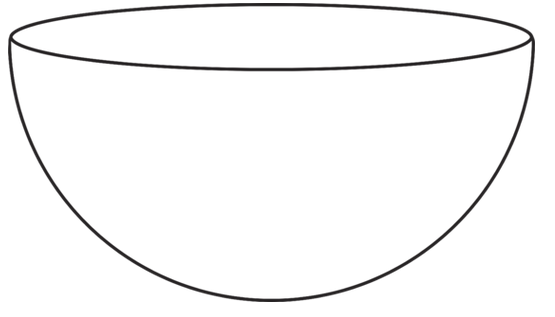
Curved surface area of the solid sphere is 24 $c{{m}^{2}}$. If the sphere is divided into two hemispheres, then the total surface area of one of the hemispheres is
A. 12 $c{{m}^{2}}$
B. 8 $c{{m}^{2}}$
C. 16 $c{{m}^{2}}$
D. 18 $c{{m}^{2}}$
Answer
465.9k+ views
Hint: We need to form the formula for surface area for a sphere. We need to equate it with the given surface area to find the radius. Then after dividing into two equal parts we need to find the change in the total surface area of one of the hemispheres. We use the value of the radius to find the solution of the problem.
Complete step-by-step answer:
Let’s assume the radius of the sphere is r cm. We have been given that the surface area of the solid sphere is 24 $c{{m}^{2}}$.
The formula for the surface area of the solid sphere is $\left( 4\pi {{r}^{2}} \right)c{{m}^{2}}$.
Now we equate these two to find $\left( 4\pi {{r}^{2}} \right)=24$. We solve to find the value of ${{r}^{2}}$.
$\begin{align}
& \left( 4\pi {{r}^{2}} \right)=24 \\
& \Rightarrow \dfrac{22}{7}{{r}^{2}}=6 \\
& \Rightarrow {{r}^{2}}=\dfrac{6\times 7}{22}=\dfrac{21}{11} \\
\end{align}$
Now the sphere is divided into two hemispheres. Every sphere has its outer curved surface area and also the lid part which is the surface area of the 2-d circle.

So, total surface area of a hemisphere is $\left( \dfrac{4\pi {{r}^{2}}}{2}+\pi {{r}^{2}} \right)c{{m}^{2}}=3\pi {{r}^{2}}c{{m}^{2}}$
We put the value of ${{r}^{2}}$ in the equation to find the total surface area of one of the hemispheres as \[3\pi {{r}^{2}}=\dfrac{3\times 22\times 21}{7\times 11}=18c{{m}^{2}}\].
The total surface area of one of the hemispheres is 18 $c{{m}^{2}}$.
So, the correct answer is “Option D”.
Note: We need to be careful about the usual surface area and total surface area. One consists of the lid part and the other doesn't. The outer surface area is just half as we are dealing with a hemisphere. We only needed to add the cover of the hemisphere.
Complete step-by-step answer:
Let’s assume the radius of the sphere is r cm. We have been given that the surface area of the solid sphere is 24 $c{{m}^{2}}$.
The formula for the surface area of the solid sphere is $\left( 4\pi {{r}^{2}} \right)c{{m}^{2}}$.
Now we equate these two to find $\left( 4\pi {{r}^{2}} \right)=24$. We solve to find the value of ${{r}^{2}}$.
$\begin{align}
& \left( 4\pi {{r}^{2}} \right)=24 \\
& \Rightarrow \dfrac{22}{7}{{r}^{2}}=6 \\
& \Rightarrow {{r}^{2}}=\dfrac{6\times 7}{22}=\dfrac{21}{11} \\
\end{align}$
Now the sphere is divided into two hemispheres. Every sphere has its outer curved surface area and also the lid part which is the surface area of the 2-d circle.

So, total surface area of a hemisphere is $\left( \dfrac{4\pi {{r}^{2}}}{2}+\pi {{r}^{2}} \right)c{{m}^{2}}=3\pi {{r}^{2}}c{{m}^{2}}$
We put the value of ${{r}^{2}}$ in the equation to find the total surface area of one of the hemispheres as \[3\pi {{r}^{2}}=\dfrac{3\times 22\times 21}{7\times 11}=18c{{m}^{2}}\].
The total surface area of one of the hemispheres is 18 $c{{m}^{2}}$.
So, the correct answer is “Option D”.
Note: We need to be careful about the usual surface area and total surface area. One consists of the lid part and the other doesn't. The outer surface area is just half as we are dealing with a hemisphere. We only needed to add the cover of the hemisphere.
Recently Updated Pages
Master Class 9 General Knowledge: Engaging Questions & Answers for Success

Master Class 9 English: Engaging Questions & Answers for Success

Master Class 9 Science: Engaging Questions & Answers for Success

Master Class 9 Social Science: Engaging Questions & Answers for Success

Master Class 9 Maths: Engaging Questions & Answers for Success

Class 9 Question and Answer - Your Ultimate Solutions Guide

Trending doubts
Fill the blanks with the suitable prepositions 1 The class 9 english CBSE

How do you graph the function fx 4x class 9 maths CBSE

Name the states which share their boundary with Indias class 9 social science CBSE

Difference Between Plant Cell and Animal Cell

What is pollution? How many types of pollution? Define it

What is the color of ferrous sulphate crystals? How does this color change after heating? Name the products formed on strongly heating ferrous sulphate crystals. What type of chemical reaction occurs in this type of change.




